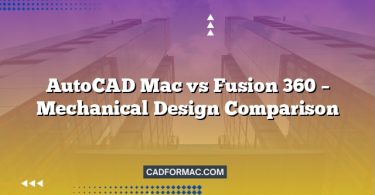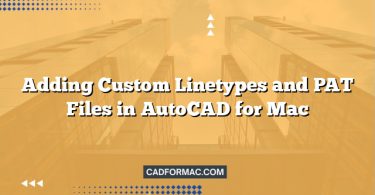When it comes to professional 2D drafting on macOS, two names consistently rise to the top: AutoCAD for Mac and DraftSight for Mac. Both applications promise precision, industry-standard compatibility, and a robust toolset tailored for architects, engineers, and designers working in a Mac environment. But which one truly delivers the best experience for 2D drafting? In this comprehensive showdown, we’ll compare AutoCAD Mac and DraftSight Mac across key categories—including interface, features, performance, pricing, and compatibility—to help you decide which CAD software deserves a place on your Mac.
Interface & User Experience
AutoCAD Mac
AutoCAD for Mac maintains the familiar ribbon-based interface that longtime AutoCAD users expect—but adapted for macOS aesthetics and workflows. The dark theme, contextual palettes, and integration with native macOS features like full-screen mode and trackpad gestures make it feel at home on Apple hardware.
However, some users note that the Mac version lags slightly behind its Windows counterpart in terms of UI polish and responsiveness. Certain dialog boxes and tool palettes can feel clunky, and customization options—while present—are more limited than on Windows.
DraftSight Mac
DraftSight takes a more minimalist approach. Its interface closely mirrors classic AutoCAD (pre-ribbon era), which appeals to users who prefer command-line efficiency and a less cluttered workspace. DraftSight’s UI is clean, responsive, and highly customizable—right-click menus, toolbars, and command aliases can be tailored to your workflow.
One standout feature is DraftSight’s Quick Access Toolbar, which provides one-click access to frequently used commands. Additionally, DraftSight integrates more seamlessly with macOS system behaviors, offering smoother scrolling, better Retina display support, and native file dialogs.
Winner: DraftSight Mac – for its cleaner, more responsive interface and superior macOS integration.
Core 2D Drafting Features
Both applications excel in fundamental 2D drafting capabilities, but differences emerge in depth and workflow efficiency.
Drawing & Editing Tools
- AutoCAD Mac offers the full suite of industry-standard drafting tools: polylines, splines, hatches, dimensions, blocks, and dynamic blocks. Its Parametric Constraints system allows for intelligent, rule-based geometry—ideal for precise engineering drawings.
- DraftSight Mac includes all essential 2D tools and supports layers, blocks, xrefs, and advanced snapping. While it lacks parametric constraints in its standard editions, DraftSight Professional and Premium add constraint-based sketching, bringing it closer to AutoCAD’s functionality.
Annotation & Dimensioning
AutoCAD’s dimensioning engine is more mature, with greater control over styles, tolerances, and associative updates. DraftSight’s annotation tools are solid but occasionally require manual adjustments for complex standards compliance.
Layer & Block Management
Both handle layers and blocks well, but AutoCAD’s Layer Properties Manager and Block Editor are more refined. DraftSight compensates with faster block insertion and a more intuitive attribute editor in recent versions.
Winner: AutoCAD Mac – for its deeper, more robust 2D toolset and parametric capabilities.
Performance & Stability
Running natively on macOS (both support Apple Silicon as of 2023–2024), performance is generally smooth on modern Macs.
- AutoCAD Mac tends to consume more system resources, especially with complex drawings or multiple viewports. Occasional crashes have been reported under heavy loads, though Autodesk has improved stability in recent updates.
- DraftSight Mac is notably lighter and faster. Startup times are quicker, panning/zooming feels snappier, and large drawings load more efficiently. Its leaner codebase translates to better day-to-day responsiveness.
Winner: DraftSight Mac – for superior speed and lower resource usage.
File Compatibility
This is a critical factor for collaborative workflows.
- AutoCAD Mac uses the native
.dwgformat (from R2.5 to 2024) and guarantees 100% compatibility with AutoCAD on Windows. It also supports.dxf,.dwt, and other Autodesk formats flawlessly. - DraftSight Mac boasts excellent
.dwgsupport (up to 2018 format in older versions; 2024 support in DraftSight 2024+) and handles.dxfreliably. However, complex drawings with dynamic blocks, custom objects, or advanced annotations may occasionally render differently than in AutoCAD.
For teams using mixed platforms or sharing files with AutoCAD users, AutoCAD remains the gold standard for compatibility.
Winner: AutoCAD Mac – for guaranteed, pixel-perfect DWG fidelity.
Pricing & Licensing
Cost is often the deciding factor—especially for freelancers, small firms, or students.
AutoCAD Mac
- Subscription-only model: $235/month or $1,890/year (as of 2024).
- Includes access to AutoCAD web and mobile apps, 3D modeling tools (though limited on Mac), and industry-specific toolsets (Architecture, Mechanical, etc.)—but only on Windows.
- No perpetual license option.
DraftSight Mac
- Offers perpetual licenses (one-time purchase) and subscriptions:
- DraftSight Standard: ~$99/year (subscription) or $249 (perpetual)
- DraftSight Professional: ~$199/year or $499 (perpetual)
- DraftSight Premium: ~$399/year or $999 (perpetual)
- Perpetual licenses include one year of updates; optional maintenance plans available.
- Free DraftSight 2D version available for students and hobbyists (limited features).
Winner: DraftSight Mac – for flexible pricing, perpetual options, and a free tier.
Platform-Specific Strengths
AutoCAD Mac Pros:
- Industry-standard name and file compatibility
- Full DWG support with zero translation issues
- Access to Autodesk ecosystem (BIM 360, Fusion 360 integration)
- Advanced parametric and sheet set management
DraftSight Mac Pros:
- Lower cost and perpetual licensing
- Faster performance on Mac hardware
- Simpler learning curve for AutoCAD veterans
- Strong macOS-native behavior (dark mode, trackpad gestures, etc.)
AutoCAD for Mac vs DraftSight for Mac – 2D Drafting Comparison Table
| Feature / Category | AutoCAD for Mac | DraftSight for Mac |
|---|---|---|
| Interface & UX | Ribbon-based, dark theme, macOS-adapted but slightly less responsive | Classic AutoCAD-style UI, highly customizable, smoother macOS integration |
| Core 2D Tools | Full suite: polylines, splines, hatches, dynamic blocks, parametric constraints | Comprehensive 2D tools; parametric constraints only in Professional/Premium editions |
| Annotation & Dimensions | Advanced, highly customizable, associative dimensions | Solid annotation tools; may require manual tweaks for complex standards |
| Layer & Block Management | Robust Layer Properties Manager, advanced Block Editor | Intuitive layer/block handling; faster block insertion |
| Performance | Higher RAM/CPU usage; occasional lag with complex files | Lightweight, faster startup, smoother panning/zooming |
| DWG Compatibility | Native .dwg support (R2.5–2024); 100% fidelity |
Excellent .dwg support (up to 2024); minor rendering differences possible |
| macOS Integration | Good (full-screen, dark mode), but some dialogs feel non-native | Excellent (Retina support, trackpad gestures, native file dialogs) |
| Apple Silicon Support | Yes (native as of recent versions) | Yes (fully optimized for M1/M2/M3 chips) |
| Pricing Model | Subscription only: ~$235/month or $1,890/year | Perpetual license + subscription options: • Standard: $249 (perpetual) / $99/yr • Professional: $499 / $199/yr • Premium: $999 / $399/yr |
| Free Version | No (30-day trial only) | Yes – DraftSight 2D (limited features, for students/hobbyists) |
| Best For | Large firms, strict DWG compliance, advanced parametrics | Freelancers, small teams, cost-conscious users, macOS-first workflowsSummary: AutoCAD leads in industry-standard compatibility and advanced features; DraftSight wins on price, performance, and macOS-native experience. |
Verdict: Which Should You Choose?
Choose AutoCAD for Mac if:
- You work in a team that relies heavily on DWG files and AutoCAD standards.
- You need parametric constraints or advanced sheet set management.
- Budget isn’t a primary concern, and you value brand reliability.
- You plan to use Windows-based AutoCAD toolsets in the future.
Choose DraftSight for Mac if:
- You prioritize performance, cost-efficiency, and macOS integration.
- Your work is primarily 2D drafting without complex parametrics.
- You prefer a one-time purchase over recurring subscriptions.
- You’re an individual user, freelancer, or small firm seeking AutoCAD-like functionality without the premium price.
Frequently Asked Questions (FAQ)
Q: Can I open AutoCAD .dwg files created on Windows in DraftSight for Mac without issues?
A: In most cases, yes—DraftSight supports .dwg files up to the latest versions (2024+) and handles standard geometry, layers, blocks, and annotations well. However, files containing dynamic blocks, custom objects (like those from AutoCAD Architecture or Mechanical toolsets), or complex parametric constraints may not display or behave identically. Always test critical files before full migration.
Q: Does DraftSight for Mac support AutoLISP or other customization scripts?
A: DraftSight does not support AutoLISP. However, it offers VBA (Visual Basic for Applications) and API-based customization (via .NET) in its Professional and Premium editions. AutoCAD for Mac includes limited AutoLISP support (fewer functions than Windows), but it’s still more robust for legacy script users.
Q: Is there a significant learning curve when switching from AutoCAD to DraftSight on Mac?
A: Not really—especially if you’re familiar with classic AutoCAD (pre-2009). DraftSight uses the same command structure, keyboard shortcuts, and coordinate input methods. Most users report being productive within hours. The main adjustments involve differences in dialog boxes, lack of the ribbon interface, and the absence of certain advanced tools unless you’re using DraftSight Premium.
Q: Can I use third-party plugins or add-ons with either program on macOS?
A: AutoCAD for Mac has limited third-party plugin support compared to Windows—many .NET or ObjectARX plugins are Windows-only. DraftSight for Mac supports a growing ecosystem of add-ons (especially via its API), but the library is smaller than AutoCAD’s. Always verify macOS compatibility before purchasing or developing plugins.
Q: Do both applications support Retina and high-DPI displays properly?
A: Yes, both AutoCAD for Mac (since 2021) and DraftSight for Mac (since 2020) offer full Retina and high-DPI support. DraftSight generally renders text and icons more crisply out of the box, while AutoCAD may require manual UI scaling adjustments in some macOS versions.
Q: Can I collaborate in real time with team members using the Windows version of either software?
A: Neither AutoCAD for Mac nor DraftSight for Mac offers true real-time co-editing like Google Docs. However, both support cloud-based file sharing (via Autodesk Drive, Dropbox, etc.). AutoCAD integrates with Autodesk Docs (part of BIM 360/Autodesk Construction Cloud), but this ecosystem is primarily optimized for Windows. DraftSight relies on standard file-sharing workflows, making cross-platform collaboration straightforward as long as file formats are compatible.
Q: Are educational licenses available for Mac users?
A: AutoCAD for Mac is included in Autodesk’s free Education Plan (1-year renewable license for students/educators). DraftSight offers a free DraftSight 2D version for students and hobbyists (no time limit), though it lacks advanced features like xrefs and batch printing. Full educational discounts for Professional/Premium editions are available through authorized resellers.
Final Thoughts
Both AutoCAD Mac and DraftSight Mac are capable 2D drafting solutions that respect the macOS environment. AutoCAD remains the industry benchmark—especially for large firms and collaborative projects requiring absolute DWG fidelity. But DraftSight offers remarkable value, delivering 90% of AutoCAD’s core 2D functionality at a fraction of the cost, with better Mac-native performance.
For most Mac-based 2D drafters—especially those working solo or in small teams—DraftSight is the smarter, more economical choice. But if you live and breathe AutoCAD workflows and standards, the premium may be worth it.
Whichever you choose, both prove that serious CAD work is not only possible on macOS—it’s thriving.
Note: Pricing and features are accurate as of mid-2024. Always check the official websites for the latest updates before purchasing.




